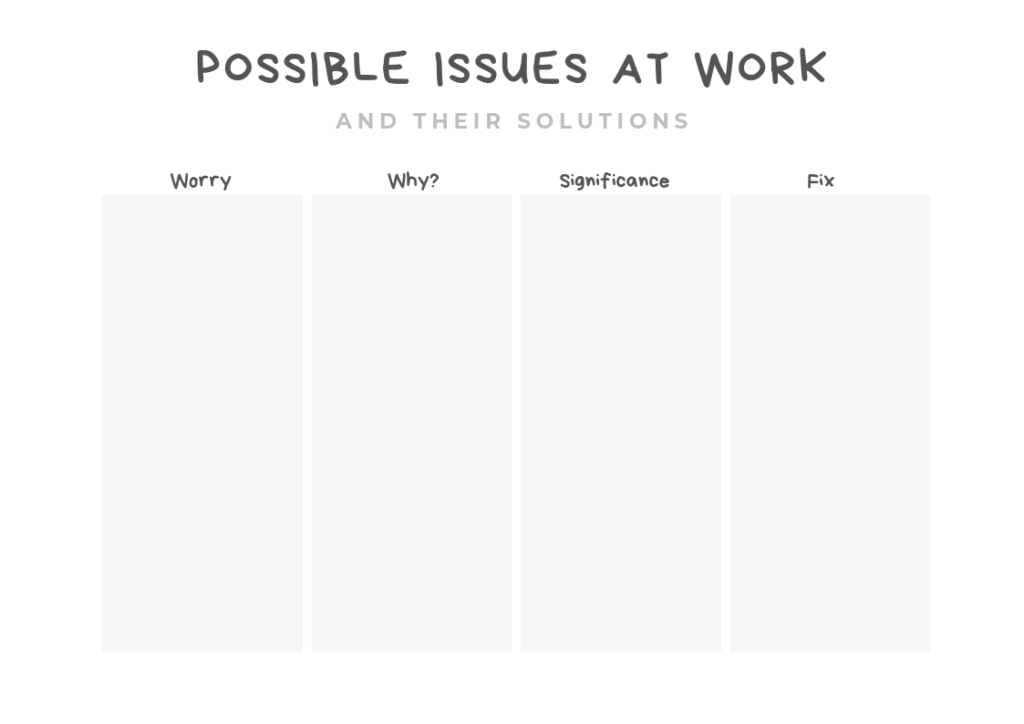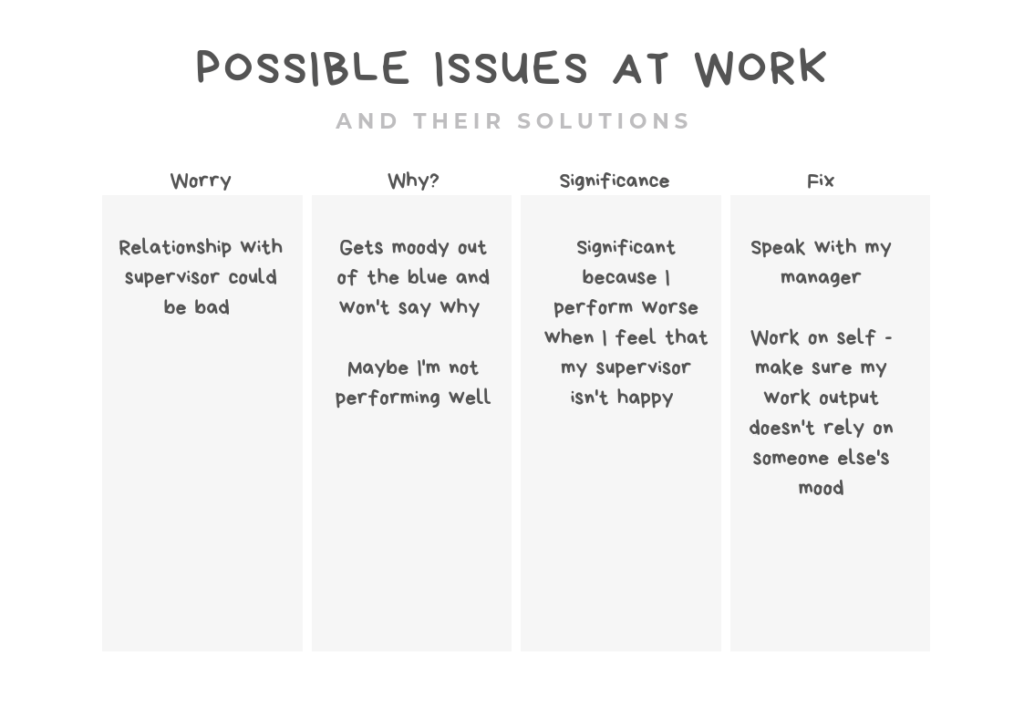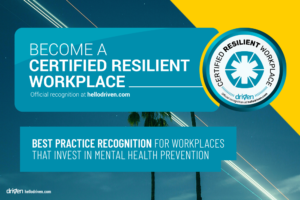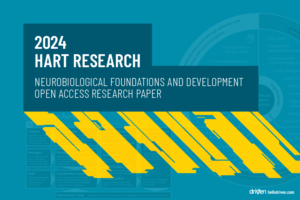The global economy loses an estimated US$1 trillion from depression and anxiety alone. There is an urgent need to inoculate workers from depression, anxiety and stress by developing resilience. In Australia, $14.81 billion a year is lost from workplace stress.[1] In America, that number is an estimated $2.5-8.5 trillion.[2] This cost is felt by employers directly through employee absenteeism and presenteeism related to stress in the workplace. Global mental health metrics document an unprecedented downward spiral.
Now is the time to invest heavily in preventative measures, and invest fast.
Learning how to deal with stress at work is crucial for the people who manage them, for the economy, and for your own personal wellbeing. So how do we recognise the signs of stress?
Symptoms of stress in the workplace
There are many ways that stress in the workplace can manifest. Being able to recognise these signs could help you manage stress early with yourself, but also recognise it sooner in others so you could help them as well. Keep an eye out for these signs of stress at work:
During Work
- Team culture at work doesn’t come easily; co-workers don’t spend much time together at work or outside of work
- Reluctance to participate in meetings or regular work; always getting distracted
- Struggling to connect with others, even your normal friends
- Being overwhelmed by small tasks
- Becoming upset by minor annoyances
- Distracting yourself on purpose from work-related tasks
- Increased absenteeism for various reasons
- Increased presenteeism (showing up at work while sick, or being present without being productive)
Outside Work
- Reluctance to go to work
- Anxiety the night before you start your workweek
- Feeling more irritable than usual
- Breathlessness at or before work
- Sleeplessness
- Self-medicating with alcohol, drugs, or even tv (keep an eye on that Netflix usage!)
- Falling sick more often than usual
- Feelings of dread or terror
- Not enjoying activities that you usually do
- Overeating or undereating
If these symptoms of workplace stress like at all like the regular symptoms of anxiety and depression, that’s because they are – the main difference is what the symptoms revolve around.
Sources of stress in the workplace + causes of stress in the workplace
Poor management can be a major cause of stress in the workplace. In fact, a study by workplace expert Dr Lindsay McMillan finds that 23% of workers would choose a new boss over getting a raise.[3]
The same study finds that poor leadership at work is the most stressful part of the job for 35% of workers. Nearly a third! And if you limit the results to only the people who are experiencing frequent high work stress, this increases to 57%.
In simpler terms, half of everyone who is stressed at work is stressed due to perceived poor management, a third of people overall have this issue. And these numbers increase for millennials.
Beyond the influence of a manager, the World Health Organisation lists additional contributors to workplace stress:[4]
- Inadequate health and safety policies
- Poor communication and management practices
- Limited participation in decision-making or low control over one’s area of work
- Low levels of support for employees
- Inflexible working hours
- Unclear tasks or organizational objectives
And to add even further to this, there are more factors that complicate the matter:
- Perceived or demanded need to work long hours
- Conflict with colleagues and managers
- Fly In Fly Out (FIFO) workers who have unique challenges. This category might include miners, rural workers, or oil rig work
- Shift work which disrupts normal sleep patterns
- Being underpaid
- Finding it hard to relate to others[5]
- Increased automation, less job security
- High mental task demands, such as air traffic control where a single mistake can be a major disaster
- Low levels of recognition and reward
You’ll notice that a lot of these issues stem from normal human needs, which are required in all areas, not just at work.
Learn more about what makes our brains happiest with these top three ways to hack your brain for resilience and the science of love.
How to deal with stress at work
Let’s dive into possible strategies for managing stress in the workplace.
These strategies will range from external to internal: There are things a person can change about themselves to become more resilient in the face of workplace stress, and there are things that may need to change about the workplace.
There are appropriate and non-appropriate strategies. For instance, a heart surgeon should not pause what they’re doing to meditate for 30 minutes. A firefighter cannot stop and do yoga. Sometimes the appropriate strategy means carrying out the responsibility, channelling that stressful emotion into energy, and then appropriately managing stress outside of the task itself.
The first steps are to figure out exactly what’s going on for you.
Step 1 - Focus on ‘How’ rather than ‘Why’
Research into how emergency services personnel cope with high levels of stress revealed an interesting difference in how your mindset can help you recover. The research looked into two types of questions that people asked themselves when they faced a really tough situation.
One group tended to ask ‘why’ questions, focusing on understanding why the event happened, what was the reason behind it, what was the purpose. These are more abstract questions that often didn’t have a clear answer.
The other group focused on ‘how’ questions, focusing on what exactly happened, how did it happen, what were the specific events that lead to this eventual outcome. These are more concrete questions that have clear answers that can be discovered.
What was found is that the group that asked more ‘how’ questions fared much better in terms of mental recovery, stress management, and reducing eventual PTSD symptoms from facing very difficult situations.
Keep that in mind when dealing with stress at work – focus on how things have happened and the concrete aspects about it. It can be tempting to ask ‘why’, but often these questions can’t be answered and it simply leaves you ruminating and getting even more stressed about it. Focusing on how makes it easier to follow through with the next steps.
Step 2 - Develop healthy responses
For everything that comes up as an issue, consider your own response, then consider what might be a more constructive response.
This can include everything from learning to breathe slowly when stressed, raising issues with compassion, or going for a walk. After all, we cannot always control what happens to us, but we can learn to control how we react to these situations. This can often feel confronting – to have to take ownership for how you respond to situations, even when those situations are very unfair or difficult.
Yet by mastering your reactions to difficult situations, you can find the power to reduce the effect it has on you, or even turn it to your advantage. The key is to have the resilience to stay calm in the moment, the willingness to search for alternatives, and to keep trying different approaches as you learn.
Step 3 - Keep a journal
If you’d like to get a better understanding of trends in your own mindset, it can be helpful to keep a journal. Often, we focus on short periods of intense stress, and ignore long periods of contentment. A journal can help you identify if what you are feeling is really an ongoing problem, or if maybe there are just occasional peaks that draw your attention.
From there, a journal can also help you figure out what in particular is adding most to the challenges you face. This can be as short or as long as you want, but make sure to jot down every day when something happens that makes you feel stressed at work.
You can go more in depth with questions like these:
- What happened?
- What does this mean?
- What’s the evidence for that?
- What evidence is there against it?
- How could this be a good thing?
- What was your response?
And of course, remember to also write down when things went well, giving you a point of comparison for later. Perhaps the good days really outnumber the bad ones?
Step 4 - Look for a solution
While many of us love a good rant, we often skip past the part where we should actually look for a solution to reduce the likelihood of something becoming a recurring theme. And it makes sense – pushing for an actual solution takes courage and vulnerability, and this is not something we always want. Or sometimes the environment can be so tough that you simply don’t feel safe to discuss alternatives.
Here you can discuss options with colleagues, or it may mean raising it with a superior. Give an overview of the problem, as well as possible solutions. If you’re right about the problem, it will hopefully benefit both of you to find a solution – a mentally healthy workplace is a maximally productive workplace.
Good and bad stress at work
Stress at work is not necessarily a bad thing.
Psychologist Michael Bell proposes that there are two lenses we can view stress in: crisis and challenge. A crisis view will create high stress and lower the oxygen flow to the brain. But a challenge view does exactly the opposite, when a stressful situation is seen as an opportunity it raises oxygen flow to the brain so you can think more clearly.
How could you turn crisis stress into a healthier challenge? These suggestions can apply both to yourself or to a colleague:
- Try to reappraise the situation. Ask yourself what can be gained here? How might this situation actually be a good thing? What advice would you give to someone else in the same situation?
- Remember past success. We easily forget both our trajectory through life and our past wins. Remind yourself of something you did well in the past (remember when you nabbed that top client? Remember when you had that super productive week? When you figured out a tough problem? Hit every KPI?).
- Engage only with things you can control. Can’t control it? Let it go. If you can do something, do something. If you can’t, then don’t – and don’t worry about it.
- Strategize. Give yourself or your worker one hour purely to strategize and don’t let them do any work for that hour. I’m talking spreadsheets. Pros and cons. Mind maps. Lego. Whatever gets those thoughts out and organised.
How do you report issues in relation to workplace stress and fatigue?
So, you’ve been in better places. You’re ready to throw in the towel. You’re part of the 25% who say they’re under insane stress at work and need a break.[6] Who do you tell, if anyone?
Many countries have some type of organisation that regulates workplace health and safety. This includes OHSA in the US, or SafeWork in Australia.
In Australia in particular your workplace is under a legal obligation to make sure the workers aren’t under too much stress. Humanrights.gov.au lists these obligations according to Australian law:
- Ensuring health and safety: Occupational Health and Safety (OHS) legislation requires employers to ensure the workplace is safe and healthy for all workers and does not cause ill health or aggravate existing conditions.
- Avoiding discrimination: disability discrimination legislation requires an employer to ensure their workplace does not discriminate against or harass workers with mental illness. The employer is also required to make reasonable adjustments to meet the needs of workers with mental illness.
- Ensuring privacy: privacy legislation requires the employer to ensure personal information about a worker’s mental health status is not disclosed to anyone without the worker’s consent.
- Avoiding adverse actions: the employer is also required under Commonwealth industrial law to ensure their workplace does not take any adverse action against a worker because of their mental illness.
Otherwise, take your manager for a coffee and chat about issues you may be having, making sure you start with the situations that are the easiest for them to change and impact.
But my boss is unreasonable, you might protest. This may be true. However, generally speaking, everyone can be reasonable in the face of well thought out cost-benefit analysis. Do research on the particular issue you are facing and communicate (clearly and warmly) all the benefits your boss might stand to gain from the change that you are suggesting. With one well-placed, well-articulated conversation, you could change an entire culture.
If bullying plays a role in your stress, this violates your rights.
In the US you can access contacts and resources on the government’s Stop Bullying website, or contact a manager or HR person. Australians can contact FairWork NSW on 13 10 50 for advice and assistance. Check online for the resources relevant to your area.
If you think you’re being bullied because of your gender, sexuality, race or religion, you should:
- visit the Human Rights Commissionwebsite for information
- speak to the Anti-Discrimination Boardof NSW
- visit our web pages on bullyingfor information on SafeWork’s role
- visit the Fair Work Ombudsman pages on bullying.
For mental health support, call:
How to reduce stress at work
You’ll notice that a lot of the causes of workplace stress stem from normal human needs, which are required in all areas, not just at work. For example, a strong social network. Having enough resources to meet demands. The balance between challenge and boredom, between control and freedom, autonomy and group identity.
These needs are true for everyone in all areas – it makes intuitive sense that these foundational requirements are needed at work.
Fortunately, research on what humans need is increasing every day. The brain is happiest when it has:
- very clear goals,
- control and flexibility in how the goals are achieved,
- a lack of conflict between different goals, and
- is making tangible progress to achieve those goals.
Of course, it needs to also happen within a supportive social network.
Learn more about what makes our brains happiest here and here.
Sometimes it’s interesting to see how fictional characters deal with stress. Often this is where we look to for our role models to see what they do when things get really tough, giving us inspiration and someone that we look up to. One particular character in recent years that showed a great amount of resilience through stressful times is Marvel’s Thor. Check out 7 Reasons Why Thor Is the Resilient Avenger.
How to help someone with stress at work
Know someone at work who is struggling with stress? There are many techniques you can use to help them, and maybe these could be useful to use on yourself as well!
1. Help them think concretely
Often people are stressed at work because they don’t have a good metric by which to evaluate the situation. For example, one week a person might feel anxious about their work, but they aren’t sure why. Or maybe they can pick out a certain factor, but they’re not sure whether it matters, whether it’s normal, or what can be done. If this describes your friend, it could be helpful for them to think in more concrete terms – to consider the specifics of the situation, instead of floundering in a nebulous sea of anxiety.
Helping someone externalise their concerns will go a long way towards helping with stress.
If you’re a colleague of the stressed person, sit down with them and chat about what they’re finding stressful. On a piece of paper, draw four columns – worry, why, significance, and fix.

- In the ‘worry’ column, write everything the person thinks might be an issue.
- In the ‘why’ column, write all possible reasons behind issues.
- In the ‘significance’ column, spend time thinking about whether it’s actually an issue. Maybe the boss is disappointed when some KPIs aren’t met – despite the best efforts of the team. That might not actually be significant; it may worry you, but it isn’t significant, because there’s nothing you can do.
- In the ‘fix’ column, write down whether the friend can fix it, and how.

This is a good way to start clarifying categories if your friend isn’t sure what to do.
Anything that isn’t significant or doesn’t have a clear fix that the colleague can achieve, cross off the list. Then take action on what’s left.
2. Give them support
Strategies help the rational side of the brain. But what about the irrational, emotional side?
The single best predictor of wellbeing is your social network – how supported and close you feel to the people around you. So, show your friend some love!
The support depends on how well you know the colleague – there are multiple ways to show support: acts of service, quality time, physical touch, gifts, words of affirmation are all key categories for showing support.
And remember, people communicate on three different levels.
- What they want
- What they need
- What they say
Maybe your colleague says they need to talk it out, but you know that every time they talk about their problem, they end up on a downward spiral of emotions that whips your friend into a frenzy and does nothing to help.
What they want could be sympathy, your affection, or emotional support.
What they need might actually be a hug and distraction. Or a drink with a friend.
The point is: wants, needs, and the things they say they want and need, can all be vastly different. When you chat with your co-worker, keep an eye out for anything that alerts you to their needs.
On a chemical level, doing things to increase dopamine and oxytocin will also help. A friendly, consensual platonic touch – like a hug, holding hands, or even a fist bump – will help increase those happy brain levels. You could also try doing something with physical exertion, like go dancing together, for a run, to a sauna, or drink tea (known to increase oxytocin) and listen to their favourite music.
Consider also whether they have anything else in their life you can help with. Are they strapped for cash? Buy them a box of that expensive gluten free flour they always need. Having external stresses can carry over into work, so peer into their life and see if there are any pressing physical needs that you can help manage.
How managers can reduce stress in the workplace
A good place to start is to measure the resilience of your staff team. But, once the team is assessed, how can employers reduce stress in the workplace? The answers are varied, but achievable, foundational, and necessary. (being part of the group while still being yourself).
A good analogy is the concept of the family. If you’re responsible for more demands than you have resources for, you’re going to be stressed.
For example, perhaps a child is responsible for bringing in money and raising their siblings. This is too much strain on their limited resources.
Or consider how a strict hierarchy will cause stress to the family – how an authoritarian parent might instil a sense of anxiety in the other family members. The most cohesive family is a tight and comfortable unit, with maximal psychological safety, both a tight knit part of the group, as well as a unique individual with autonomy. Demands do not exceed resources. The kids aren’t worried about being fired from the family due to encroaching automation of childhood.
(The main difference in this analogy is that an employment relation is one of demand and compensation, whereas a familial relationship is unconditional and permanent).
However, the main takeaway is that work is not separate from life (much as everyone likes the idea of the work-life balance) and we don’t leave our humanity at home.
With this in mind, let’s talk about how employers can reduce stress in the workplace and maximise employee wellbeing and productivity.
LaMontagne’s (2007) framework for addressing workplace stress has these three steps:[7]
- Primary – Remove or prevent workplace stressors
- Secondary – Modify the workers’ response to stress
- Tertiary – Address any stress-related illnesses
Example Situation
Consider an example. In a certain workplace, the boss is abrasive and communicates poorly. Several employees are constantly under stress because their goals aren’t clear, and the social environment is uncomfortable.
Primary Response - Remove stressors
The primary response here – removing workplace stressors – would be to prevent this situation from ever occurring in the first place, by hiring a more personable manager, or training them on communication style.
One of the best ways to prevent stress is to develop resilience in the team. What we’ve seen through our own research in 2017 is that an increase in resilience directly correlates with an increase in job satisfaction.
Secondary Response - Modify response
A secondary response would involve helping employees to remove any personal stress this causes them at work. Perhaps stress management training or meditation classes, or training them in resilience so that personal feedback is received constructively (of course it also helps when feedback is delivered constructively).
Tertiary Response - Address illness
The tertiary response here could look like counselling, or some paid time off to recuperate.
Keep in mind that these approaches are not necessarily exclusive, nor do they need to be done in separate stages. In fact, it’s useful to do all three in tandem.
What’s the most important strategy of the three steps for managing stress in the workplace?
This may sound like a trick question – all three are important, of course – but actually, primary intervention (the first step) is the most important stress management strategy.
Secondary prevention strategies complement primary prevention, which then maximises the benefits of the tertiary strategies.
The best primary strategy is both to remove stressors, and to build resilience. There are quality enterprise resilience programs available that are scientifically verified and empirically effective.
The global head of Leadership Development Solutions, Dennis Baltzley, suggests a number of restructuring techniques, including:
- Changing the structure of firms to flatten stressful top-down corporate structures
- Getting rid of authoritarian leadership styles
- Training employees in new technologies
- Training managers in knowing how best to lead
In a study by Korn Ferry, they found that lowering the amount hours is not always the most effective way to lower stress. In fact, it might be harmful – 79% of respondents say not having enough work is more stressful than having too much work. Similarly, 74% of respondents would work more and earn more than work less and be compensated less.
Workplace stress statistics (worldwide incl. Australia)
These statistics paint a concerning picture of workplace stress:
- Every $1 investment into mental health in the workplace has an estimated return of $4.[8]
- 80% of workers feel stress on the job and nearly half say they need help in learning how to manage stress. And 42% say their co-workers need such help (American Institute of Stress)
- Stress levels in the workplace are rising with 6 in 10 workers in major global economies experiencing increased workplace stress (The Regus Group)
- Less than half of Australians (47%) are comfortable letting their managers know they have a mental health condition.
- the top three causes of rising stress levels as: growing workloads (61 per cent), increased business expectations (52 per cent) and short deadlines (37 per cent).[9]
- Only half of respondents say their workplace is mentally healthy (52%)[10]
Can you claim for stress at work
The bad news: stress, on its own, is not an illness, so stress cannot be claimed for.
The good news: stress is often a symptom of mental illness, which can be claimed for.
The Work Health and Safety Act 2011 defines health as both physical and psychological.
Usually, the process includes calculating where you should be if it were not for your work stress-related illness, in money terms, and where you are now.
Different countries will have different processes – have a look for any government or corporate bodies overseeing workplace safety.
For example, Australia has Insurance And Care (icare), State InState Insurance Regulatory Authority (SIRA), and SafeWorkNSW.
SafeWork NSW is the organisation responsible for overseeing worker’s compensation claims in New South Wales, although their help can often be applied elsewhere. SafeWork NSW assesses the situation, but is not responsible for maximising compensation, so you may want additional legal help.
You can claim psychological injury with enough medical evidence – preferably a solid diagnosis.
You can look through the official Workers Compensation guidelines at https://www.sira.nsw.gov.au/resources-library/workers-compensation-resources/publications/workers-and-claims/workers-compensation-guidelines
This is a great link for resources and info:
https://www.comcare.gov.au/preventing/hazards/psychosocial_hazards/work-related_mental_stress
References
[1] Medibank 2008
[2] Medibank 2008
[3] Dr Lindsay McMillan OAM, 2016 Snapshot of the Australian Workplace
[4] https://www.who.int/mental_health/in_the_workplace/en/
[5] Jurie Rossouw, Executive Resilience
[6] Slocombe, P. 2017. Why we are missing the mark on mental health; results of Australia’s Biggest Mental Health Check-in. Vital Conversations and Medibio.
[7] LaMontagne, A. D., Keegel, T., & Vallance, D. (2007). Protecting and promoting mental health in the workplace: developing a systems approach to job stress. Health Promotion Journal of Australia, 18(3), 221-228.
[8] McDaid, D., Park, A.-L., & Wahlbeck, K. (2019). The economic case for the prevention of mental illness. Annual review of public health, 40, 373-389.
[9] Dr Lindsay McMillan OAM, 2016 Snapshot of the Australian Workplace
[10] The State of Workplace Mental Health In Australia, BeyondBlue


